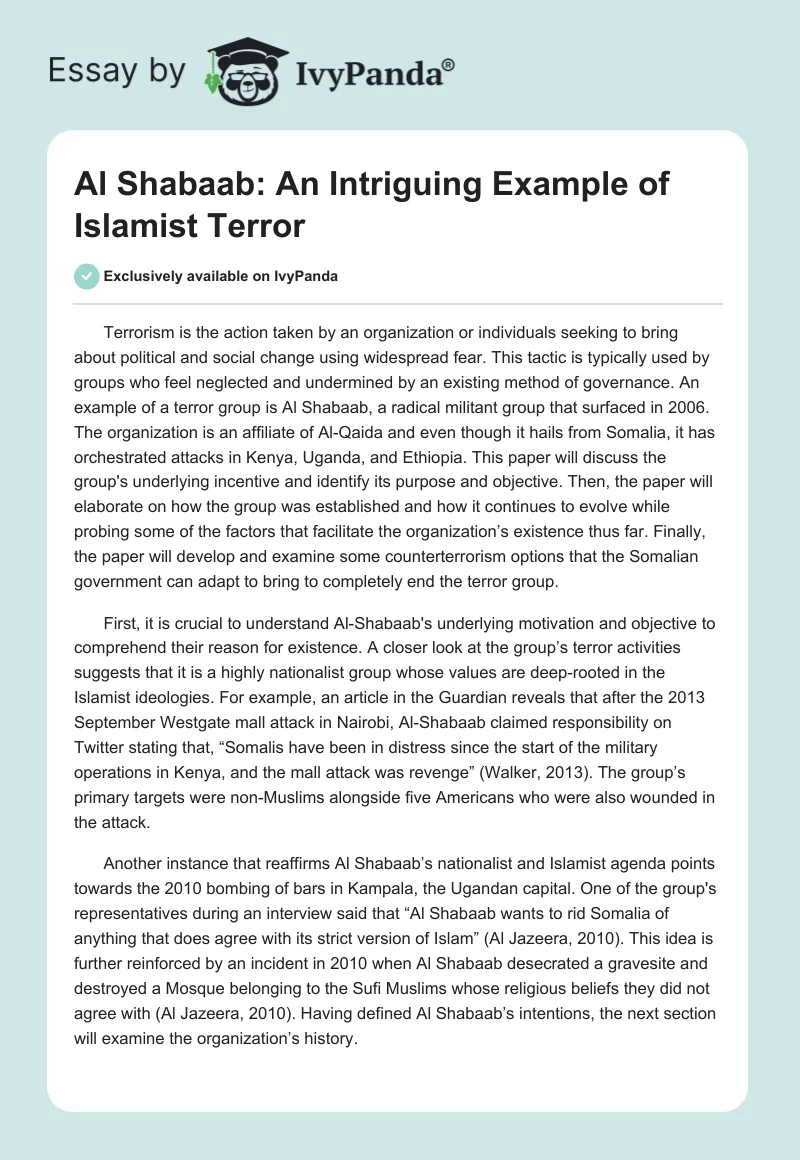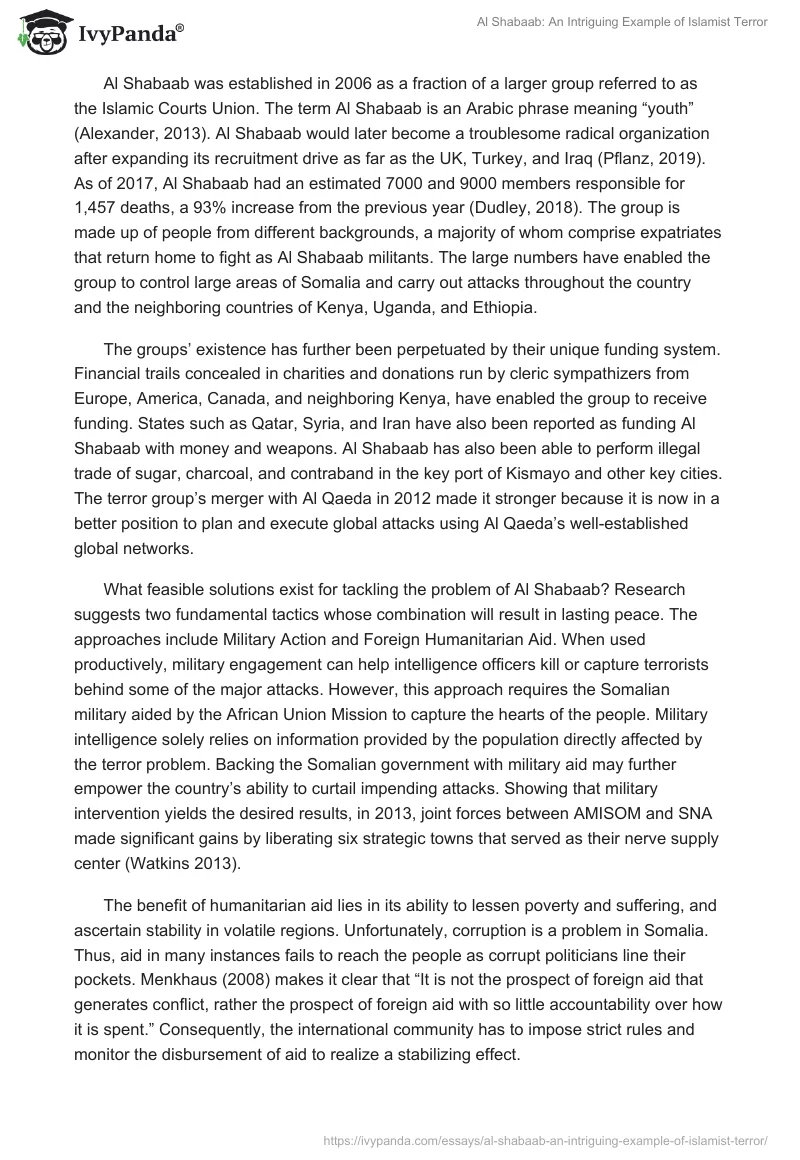Terrorism is the action taken by an organization or individuals seeking to bring about political and social change using widespread fear. This tactic is typically used by groups who feel neglected and undermined by an existing method of governance. An example of a terror group is Al Shabaab, a radical militant group that surfaced in 2006. The organization is an affiliate of Al-Qaida and even though it hails from Somalia, it has orchestrated attacks in Kenya, Uganda, and Ethiopia. This paper will discuss the group’s underlying incentive and identify its purpose and objective. Then, the paper will elaborate on how the group was established and how it continues to evolve while probing some of the factors that facilitate the organization’s existence thus far. Finally, the paper will develop and examine some counterterrorism options that the Somalian government can adapt to bring to completely end the terror group.
First, it is crucial to understand Al-Shabaab’s underlying motivation and objective to comprehend their reason for existence. A closer look at the group’s terror activities suggests that it is a highly nationalist group whose values are deep-rooted in the Islamist ideologies. For example, an article in the Guardian reveals that after the 2013 September Westgate mall attack in Nairobi, Al-Shabaab claimed responsibility on Twitter stating that, “Somalis have been in distress since the start of the military operations in Kenya, and the mall attack was revenge” (Walker, 2013). The group’s primary targets were non-Muslims alongside five Americans who were also wounded in the attack.
Another instance that reaffirms Al Shabaab’s nationalist and Islamist agenda points towards the 2010 bombing of bars in Kampala, the Ugandan capital. One of the group’s representatives during an interview said that “Al Shabaab wants to rid Somalia of anything that does agree with its strict version of Islam” (Al Jazeera, 2010). This idea is further reinforced by an incident in 2010 when Al Shabaab desecrated a gravesite and destroyed a Mosque belonging to the Sufi Muslims whose religious beliefs they did not agree with (Al Jazeera, 2010). Having defined Al Shabaab’s intentions, the next section will examine the organization’s history.
Al Shabaab was established in 2006 as a fraction of a larger group referred to as the Islamic Courts Union. The term Al Shabaab is an Arabic phrase meaning “youth” (Alexander, 2013). Al Shabaab would later become a troublesome radical organization after expanding its recruitment drive as far as the UK, Turkey, and Iraq (Pflanz, 2019). As of 2017, Al Shabaab had an estimated 7000 and 9000 members responsible for 1,457 deaths, a 93% increase from the previous year (Dudley, 2018). The group is made up of people from different backgrounds, a majority of whom comprise expatriates that return home to fight as Al Shabaab militants. The large numbers have enabled the group to control large areas of Somalia and carry out attacks throughout the country and the neighboring countries of Kenya, Uganda, and Ethiopia.
The groups’ existence has further been perpetuated by their unique funding system. Financial trails concealed in charities and donations run by cleric sympathizers from Europe, America, Canada, and neighboring Kenya, have enabled the group to receive funding. States such as Qatar, Syria, and Iran have also been reported as funding Al Shabaab with money and weapons. Al Shabaab has also been able to perform illegal trade of sugar, charcoal, and contraband in the key port of Kismayo and other key cities. The terror group’s merger with Al Qaeda in 2012 made it stronger because it is now in a better position to plan and execute global attacks using Al Qaeda’s well-established global networks.
What feasible solutions exist for tackling the problem of Al Shabaab? Research suggests two fundamental tactics whose combination will result in lasting peace. The approaches include Military Action and Foreign Humanitarian Aid. When used productively, military engagement can help intelligence officers kill or capture terrorists behind some of the major attacks. However, this approach requires the Somalian military aided by the African Union Mission to capture the hearts of the people. Military intelligence solely relies on information provided by the population directly affected by the terror problem. Backing the Somalian government with military aid may further empower the country’s ability to curtail impending attacks. Showing that military intervention yields the desired results, in 2013, joint forces between AMISOM and SNA made significant gains by liberating six strategic towns that served as their nerve supply center (Watkins 2013).
The benefit of humanitarian aid lies in its ability to lessen poverty and suffering, and ascertain stability in volatile regions. Unfortunately, corruption is a problem in Somalia. Thus, aid in many instances fails to reach the people as corrupt politicians line their pockets. Menkhaus (2008) makes it clear that “It is not the prospect of foreign aid that generates conflict, rather the prospect of foreign aid with so little accountability over how it is spent.” Consequently, the international community has to impose strict rules and monitor the disbursement of aid to realize a stabilizing effect.
Al Shabaab has managed to wreak terror for years while trying to shape the future and direction of Somalia. However, the combined efforts of the Somalia Defense Forces and AMISON have resulted in the group’s loss of control over the Southern lands. A majority of security analysts considered the Westgate mall attack as a sign of the terror group’s last gasps. In essence, Al Shabaab has been left with the single option of carrying out terror attacks having lost ground in the nation from which it once ruled over. Through the tactics discussed in this paper, the international community can foster lasting peace and save Somalia from the oppression and violence brought by Al Shabaab.
References
- Alexander, G. (2013). Al-shabaab: the rise of a youth-led islamist movement. Web.
- Al Jazeera. (2010). Grave sites destroyed in somalia – africa – al jazeera english. Web.
- Dudley, D. (2018). The Deadliest Terrorist Groups In The World Today. Forbes Magazine. Web.
- Menkhaus, K. (2008). International policies and politics in the humanitarian crisis in somalia. Humanitarian Exchange Magazine, (40).
- Walker, J. (2013). Westgate siege: Al-shabab claims kenyan forces used chemical weapons, buried 137 hostages (video/photos).
- Watkins, T., Lister, T., Starr, B., Newton, P., McKenzie, D., & Labott, E. (2013). Al-shabaab grew amid somalia’s lawlessness. Web.


